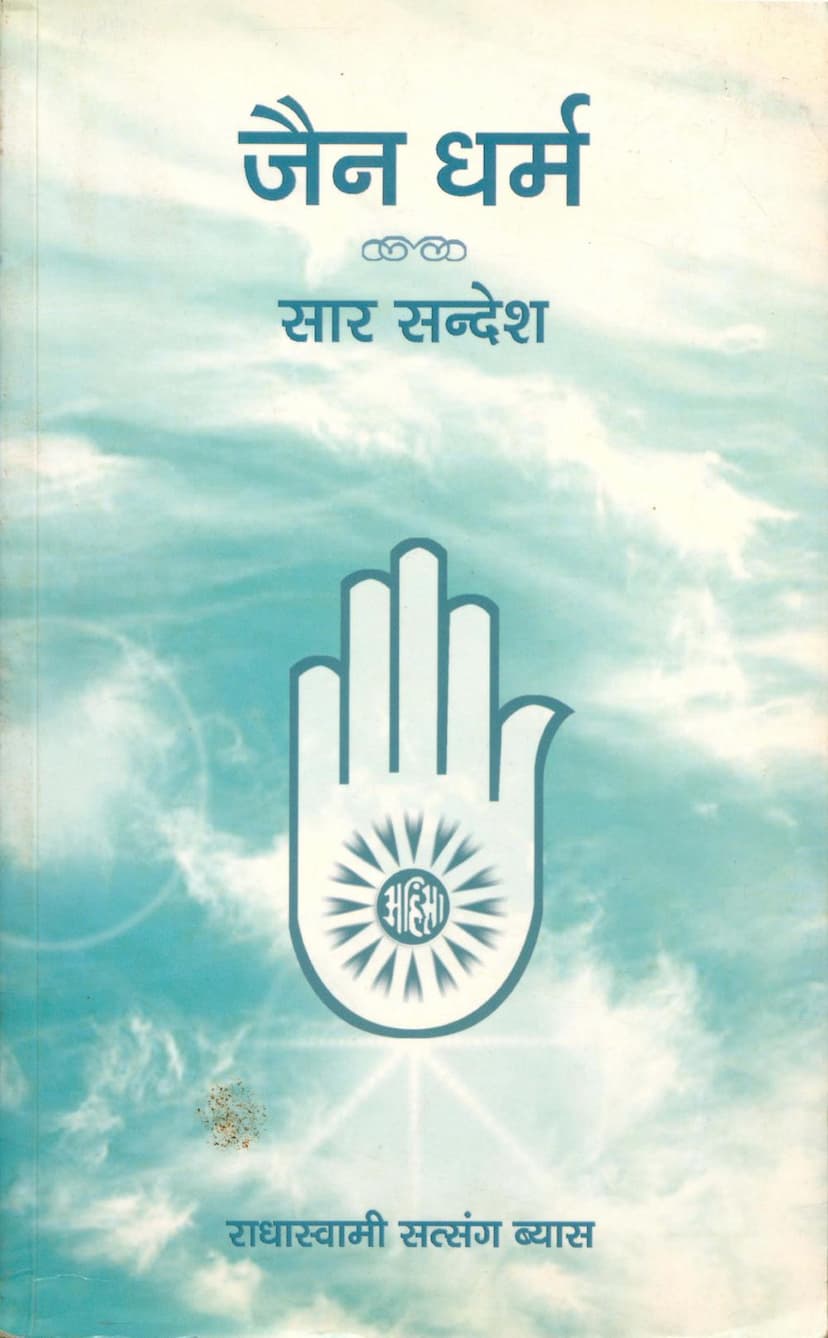Jain Dharm Sar Sandesh
Added to library: September 1, 2025

Summary
This is a comprehensive summary of the Jain text "Jain Dharm Saar Sandesh" by Kashinath Upadhyay, published by Radha Soami Satsang Beas.
Overall Purpose:
The book aims to present the fundamental principles, ethics, philosophy, and practices of Jainism in a simple, authentic, and accessible manner. It emphasizes that Jainism is not confined to any specific person, group, sect, or caste, but offers a path to spiritual welfare for all humanity, transcending all narrowness.
Key Themes and Content:
The book is structured into ten chapters, covering a wide range of Jain teachings and philosophy:
-
Ancient Origins of Jainism:
- Explains the meaning of "Jain," "Jin," and "Tirthankar," highlighting the concept of conquerors who have overcome inner passions.
- Traces the lineage of Tirthankaras, Gandharas, and Acharyas, emphasizing the long and unbroken tradition of Jainism.
- Provides a brief biography of Mahavir Swami, the 24th Tirthankara.
- Discusses the rich and extensive Jain literature.
-
The Nature of Jainism:
- Asserts that all beings seek happiness and that Jainism provides the path to true, lasting happiness.
- Defines Jainism as a path to recognizing the true self and achieving liberation.
- Outlines the general and specific characteristics of Jainism, emphasizing its liberal and inclusive outlook.
- Clarifies what Jainism is not, likely addressing misconceptions or superficial interpretations.
-
Soul, Bondage, and Liberation (Moksha):
- Differentiates between the soul (Jiva) and non-soul (Ajeva) substances.
- Identifies karma as the root cause of bondage.
- Explains the concept of Moksha (liberation) as freedom from the cycle of birth and death.
- Details the process of breaking free from bondage and the path to Moksha, which is the "Ratnatraya" (three jewels).
-
Ahimsa (Non-violence):
- Elaborates on the profound nature of Ahimsa in Jainism, extending beyond mere physical non-killing to include mental and verbal non-violence.
- Discusses the practice of Ahimsa for householders.
- Highlights the supreme importance and glory of Ahimsa, while strongly condemning violence.
- Explains the prohibition of meat and alcohol.
-
Human Life:
- Emphasizes the rarity and preciousness of human birth.
- Discusses the transient and impermanent nature of human life.
- Explores the meaningfulness and purpose of human existence.
- Also touches upon the potential meaninglessness of human life if its true purpose is ignored.
-
The Guru:
- Explains the necessity of a Guru for spiritual guidance.
- Defines the qualities and nature of a true Guru.
- Discusses the fruits of finding a Guru.
- Outlines the duties of a disciple and warns against the harms of serving a false Guru.
-
Divya Dhvani (Divine Voice):
- Describes the nature of the divine voice or enlightened speech emanating from Tirthankaras.
- Explains the impact and significance of this divine voice in conveying spiritual truths.
-
Anupeksha (Contemplation/Meditation):
- Lists and explains contemplations that foster detachment and renunciation.
- Details contemplations that help stabilize the mind for meditation.
-
Internal Sadhana (Spiritual Practice):
- Focuses on the control of the mind.
- Highlights the indispensability of meditation.
- Describes the nature and types of meditation.
- Discusses meditating on the Guru's form, chanting mantras, "Anahata Dhyana" (unstruck sound meditation), and "Rupastha" and "Rupatita" (meditation with and without form).
- Outlines the essential qualities of a meditator and the appropriate posture, place, and time for meditation, along with its fruits.
-
From Soul to Supreme Soul (Paramatma):
- Explains the stages of spiritual evolution: Bahiratama (outer soul, engrossed in external), Antaratma (inner soul, turning inwards), and Paramatma (Supreme Soul, fully liberated).
Author and Publisher:
- Author: Dr. Kashinath Upadhyay, described as a renowned scholar of Indian philosophy with extensive teaching and research experience in India and the USA.
- Publisher: Radha Soami Satsang Beas, represented by J. C. Sethi, Secretary.
- Copyright: 2010 by Radha Soami Satsang Beas.
- ISBN: 978-81-8256-924-9
Key Philosophical Underpinnings:
- The Soul (Jiva): The soul is presented as a conscious, eternal, and indestructible entity, inherently filled with infinite bliss.
- Karma: Karma is identified as the primary cause of bondage, obscuring the soul's true nature.
- Ahimsa: Non-violence is the cornerstone of Jain ethics and practice, understood in its broadest sense.
- Ratnatraya: The path to liberation (Moksha) is through Right Faith (Samyak Darshan), Right Knowledge (Samyak Gyan), and Right Conduct (Samyak Charitra).
- Syadvada: The principle of conditional predication, promoting a balanced, non-absolute, and inclusive approach to understanding reality.
- Self-Realization: The ultimate goal is to recognize the true nature of the soul and realize its inherent divinity.
Core Message:
The book emphasizes that true happiness and peace are found not in external pursuits but within the self. By controlling the senses, understanding the transient nature of the world, cultivating virtues like Ahimsa, and following the path laid out by the Tirthankaras and Gurus, individuals can achieve liberation and eternal bliss. It encourages a life of self-discipline, detachment, and spiritual inquiry.
Target Audience:
The book is intended for sincere seekers of truth, spiritual practitioners, and the general readership interested in understanding Jainism's core teachings.
In essence, "Jain Dharm Saar Sandesh" serves as a guide to the essential doctrines and practices of Jainism, presented with clarity and depth, aiming to lead the reader towards self-realization and spiritual liberation.